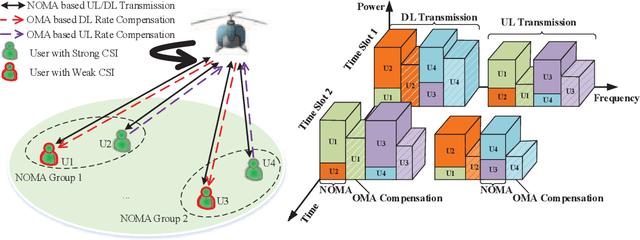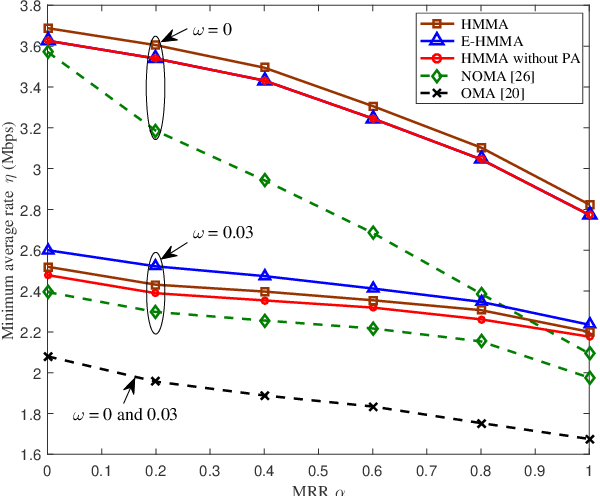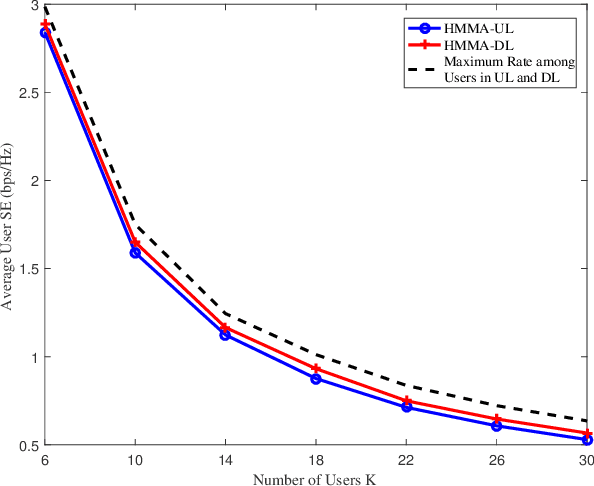Xu Zhu
Basis Expansion Extrapolation based Long-Term Channel Prediction for Massive MIMO OTFS Systems
Jul 02, 2025Abstract:Massive multi-input multi-output (MIMO) combined with orthogonal time frequency space (OTFS) modulation has emerged as a promising technique for high-mobility scenarios. However, its performance could be severely degraded due to channel aging caused by user mobility and high processing latency. In this paper, an integrated scheme of uplink (UL) channel estimation and downlink (DL) channel prediction is proposed to alleviate channel aging in time division duplex (TDD) massive MIMO-OTFS systems. Specifically, first, an iterative basis expansion model (BEM) based UL channel estimation scheme is proposed to accurately estimate UL channels with the aid of carefully designed OTFS frame pattern. Then a set of Slepian sequences are used to model the estimated UL channels, and the dynamic Slepian coefficients are fitted by a set of orthogonal polynomials. A channel predictor is derived to predict DL channels by iteratively extrapolating the Slepian coefficients. Simulation results verify that the proposed UL channel estimation and DL channel prediction schemes outperform the existing schemes in terms of normalized mean square error of channel estimation/prediction and DL spectral efficiency, with less pilot overhead.
Multi-Reference and Adaptive Nonlinear Transform Source-Channel Coding for Wireless Image Semantic Transmission
May 19, 2025Abstract:We propose a multi-reference and adaptive nonlinear transform source-channel coding (MA-NTSCC) system for wireless image semantic transmission to improve rate-distortion (RD) performance by introducing multi-dimensional contexts into the entropy model of the state-of-the-art (SOTA) NTSCC system. Improvements in RD performance of the proposed MA-NTSCC system are particularly significant in high-resolution image transmission under low bandwidth constraints. The proposed multi-reference entropy model leverages correlations within the latent representation in both spatial and channel dimensions. In the spatial dimension, the latent representation is divided into anchors and non-anchors in a checkerboard pattern, where anchors serve as reference to estimate the mutual information between anchors and non-anchors. In the channel dimension, the latent representation is partitioned into multiple groups, and features in previous groups are analyzed to estimate the mutual information between features in previous and current groups. Taking mutual information into account, the entropy model provides an accurate estimation on the entropy, which enables efficient bandwidth allocation and enhances RD performance. Additionally, the proposed lightweight adaptation modules enable the proposed MA-NTSCC model to achieve transmission quality comparable to separately trained models across various channel conditions and bandwidth requirements. In contrast, traditional NTSCC models provide signal-to-noise ratio (SNR)-distortion performance degrading with channel quality deviating from the fixed training SNR, and consume inflexible bandwidth to transmit an image. Comprehensive experiments are conducted to verify the peak signal-to-noise ratio (PSNR) performance and adaptability of the proposed MA-NTSCC model superior to SOTA methods over both additive white Gaussian noise channel and Rayleigh fading channel.
OptMetaOpenFOAM: Large Language Model Driven Chain of Thought for Sensitivity Analysis and Parameter Optimization based on CFD
Mar 03, 2025Abstract:Merging natural language interfaces with computational fluid dynamics (CFD) workflows presents transformative opportunities for both industry and research. In this study, we introduce OptMetaOpenFOAM - a novel framework that bridges MetaOpenFOAM with external analysis and optimization tool libraries through a large language model (LLM)-driven chain-of-thought (COT) methodology. By automating complex CFD tasks via natural language inputs, the framework empowers non-expert users to perform sensitivity analyses and parameter optimizations with markedly improved efficiency. The test dataset comprises 11 distinct CFD analysis or optimization tasks, including a baseline simulation task derived from an OpenFOAM tutorial covering fluid dynamics, combustion, and heat transfer. Results confirm that OptMetaOpenFOAM can accurately interpret user requirements expressed in natural language and effectively invoke external tool libraries alongside MetaOpenFOAM to complete the tasks. Furthermore, validation on a non-OpenFOAM tutorial case - namely, a hydrogen combustion chamber - demonstrates that a mere 200-character natural language input can trigger a sequence of simulation, postprocessing, analysis, and optimization tasks spanning over 2,000 lines of code. These findings underscore the transformative potential of LLM-driven COT methodologies in linking external tool for advanced analysis and optimization, positioning OptMetaOpenFOAM as an effective tool that streamlines CFD simulations and enhances their convenience and efficiency for both industrial and research applications. Code is available at https://github.com/Terry-cyx/MetaOpenFOAM.
RSSI Positioning with Fluid Antenna Systems
Mar 02, 2025Abstract:We introduce a novel received signal strength intensity (RSSI)-based positioning method using fluid antenna systems (FAS), leveraging their inherent channel correlation properties to improve location accuracy. By enabling a single antenna to sample multiple spatial positions, FAS exhibits high correlation between its ports. We integrate this high inter-port correlation with a logarithmic path loss model to mitigate the impact of fast fading on RSSI signals, and derive a simplified multipoint positioning model based on the established relationship between channel correlation and RSSI signal correlation. A maximum likelihood estimator (MLE) is then developed, for which we provide a closed-form solution. Results demonstrate that our approach outperforms both traditional least squares (LS) methods and single-antenna systems, achieving accuracy comparable to conventional multi-antenna positioning. Furthermore, we analyze the impact of different antenna structures on positioning performance, offering practical guidance for FAS antenna design.
Goal-Oriented Integration of Sensing, Communication, Computing, and Control for Mission-Critical Internet-of-Things
Jan 02, 2024Abstract:Driven by the development goal of network paradigm and demand for various functions in the sixth-generation (6G) mission-critical Internet-of-Things (MC-IoT), we foresee a goal-oriented integration of sensing, communication, computing, and control (GIS3C) in this paper. We first provide an overview of the tasks, requirements, and challenges of MC-IoT. Then we introduce an end-to-end GIS3C architecture, in which goal-oriented communication is leveraged to bridge and empower sensing, communication, control, and computing functionalities. By revealing the interplay among multiple subsystems in terms of key performance indicators and parameters, this paper introduces unified metrics, i.e., task completion effectiveness and cost, to facilitate S3C co-design in MC-IoT. The preliminary results demonstrate the benefits of GIS3C in improving task completion effectiveness while reducing costs. We also identify and highlight the gaps and challenges in applying GIS3C in the future 6G networks.
Towards Structural Sparse Precoding: Dynamic Time, Frequency, Space, and Power Multistage Resource Programming
Oct 15, 2023Abstract:In last decades, dynamic resource programming in partial resource domains has been extensively investigated for single time slot optimizations. However, with the emerging real-time media applications in fifth-generation communications, their new quality of service requirements are often measured in temporal dimension. This requires multistage optimization for full resource domain dynamic programming. Taking experience rate as a typical temporal multistage metric, we jointly optimize time, frequency, space and power domains resource for multistage optimization. To strike a good tradeoff between system performance and computational complexity, we first transform the formulated mixed integer non-linear constraints into equivalent convex second order cone constraints, by exploiting the coupling effect among the resources. Leveraging the concept of structural sparsity, the objective of max-min experience rate is given as a weighted 1-norm term associated with the precoding matrix. Finally, a low-complexity iterative algorithm is proposed for full resource domain programming, aided by another simple conic optimization for obtaining its feasible initial result. Simulation verifies that our design significantly outperform the benchmarks while maintaining a fast convergence rate, shedding light on full domain dynamic resource programming of multistage optimizations.
Performance Analysis of OTSM under Hardware Impairments in Millimeter-Wave Vehicular Communication Networks
Sep 08, 2023



Abstract:Orthogonal time sequency multiplexing (OTSM) has been recently proposed as a single-carrier (SC) waveform offering similar bit error rate (BER) to multi-carrier orthogonal time frequency space (OTFS) modulation in doubly-spread channels under high mobilities; however, with much lower complexity making OTSM a promising candidate for low-power millimeter-wave (mmWave) vehicular communications in 6G wireless networks. In this paper, the performance of OTSM-based homodyne transceiver is explored under hardware impairments (HIs) including in-phase and quadrature imbalance (IQI), direct current offset (DCO), phase noise, power amplifier non-linearity, carrier frequency offset, and synchronization timing offset. First, the discrete-time baseband signal model is obtained in vector form under the mentioned HIs. Then, the system input-output relations are derived in time, delay-time, and delay-sequency (DS) domains in which the parameters of HIs are incorporated. Analytical studies demonstrate that noise stays white Gaussian and effective channel matrix is sparse in the DS domain under HIs. Also, DCO appears as a DC signal at receiver interfering with only the zero sequency over all delay taps in the DS domain; however, IQI redounds to self-conjugated fully-overlapping sequency interference. Simulation results reveal the fact that with no HI compensation (HIC), not only OTSM outperforms plain SC waveform but it performs close to uncompensated OTFS system; however, HIC is essentially needed for OTSM systems operating in mmWave and beyond frequency bands.
A Hierarchical Hybrid Learning Framework for Multi-agent Trajectory Prediction
Mar 24, 2023



Abstract:Accurate and robust trajectory prediction of neighboring agents is critical for autonomous vehicles traversing in complex scenes. Most methods proposed in recent years are deep learning-based due to their strength in encoding complex interactions. However, unplausible predictions are often generated since they rely heavily on past observations and cannot effectively capture the transient and contingency interactions from sparse samples. In this paper, we propose a hierarchical hybrid framework of deep learning (DL) and reinforcement learning (RL) for multi-agent trajectory prediction, to cope with the challenge of predicting motions shaped by multi-scale interactions. In the DL stage, the traffic scene is divided into multiple intermediate-scale heterogenous graphs based on which Transformer-style GNNs are adopted to encode heterogenous interactions at intermediate and global levels. In the RL stage, we divide the traffic scene into local sub-scenes utilizing the key future points predicted in the DL stage. To emulate the motion planning procedure so as to produce trajectory predictions, a Transformer-based Proximal Policy Optimization (PPO) incorporated with a vehicle kinematics model is devised to plan motions under the dominant influence of microscopic interactions. A multi-objective reward is designed to balance between agent-centric accuracy and scene-wise compatibility. Experimental results show that our proposal matches the state-of-the-arts on the Argoverse forecasting benchmark. It's also revealed by the visualized results that the hierarchical learning framework captures the multi-scale interactions and improves the feasibility and compliance of the predicted trajectories.
Toward UL-DL Rate Balancing: Joint Resource Allocation and Hybrid-Mode Multiple Access for UAV-BS Assisted Communication Systems
Nov 16, 2021



Abstract:In this paper, we investigate unmanned aerial vehicle (UAV) assisted communication systems that require quasi-balanced data rates in uplink (UL) and downlink (DL), as well as users' heterogeneous traffic. To the best of our knowledge, this is the first work to explicitly investigate joint UL-DL optimization for UAV assisted systems under heterogeneous requirements. A hybrid-mode multiple access (HMMA) scheme is proposed toward heterogeneous traffic, where non-orthogonal multiple access (NOMA) targets high average data rate, while orthogonal multiple access (OMA) aims to meet users' instantaneous rate demands by compensating for their rates. HMMA enables a higher degree of freedom in multiple access and achieves a superior minimum average rate among users than the UAV assisted NOMA or OMA schemes. Under HMMA, a joint UL-DL resource allocation algorithm is proposed with a closed-form optimal solution for UL/DL power allocation to achieve quasi-balanced average rates for UL and DL. Furthermore, considering the error propagation in successive interference cancellation (SIC) of NOMA, an enhanced-HMMA scheme is proposed, which demonstrates high robustness against SIC error and a higher minimum average rate than the HMMA scheme.
Stochastic Lipschitz Q-Learning
May 15, 2019Abstract:In an episodic Markov Decision Process (MDP) problem, an online algorithm chooses from a set of actions in a sequence of $H$ trials, where $H$ is the episode length, in order to maximize the total payoff of the chosen actions. Q-learning, as the most popular model-free reinforcement learning (RL) algorithm, directly parameterizes and updates value functions without explicitly modeling the environment. Recently, [Jin et al. 2018] studies the sample complexity of Q-learning with finite states and actions. Their algorithm achieves nearly optimal regret, which shows that Q-learning can be made sample efficient. However, MDPs with large discrete states and actions [Silver et al. 2016] or continuous spaces [Mnih et al. 2013] cannot learn efficiently in this way. Hence, it is critical to develop new algorithms to solve this dilemma with provable guarantee on the sample complexity. With this motivation, we propose a novel algorithm that works for MDPs with a more general setting, which has infinitely many states and actions and assumes that the payoff function and transition kernel are Lipschitz continuous. We also provide corresponding theory justification for our algorithm. It achieves the regret $\tilde{\mathcal{O}}(K^{\frac{d+1}{d+2}}\sqrt{H^3}),$ where $K$ denotes the number of episodes and $d$ denotes the dimension of the joint space. To the best of our knowledge, this is the first analysis in the model-free setting whose established regret matches the lower bound up to a logarithmic factor.
 Add to Chrome
Add to Chrome Add to Firefox
Add to Firefox Add to Edge
Add to Edge